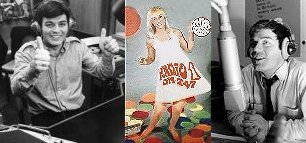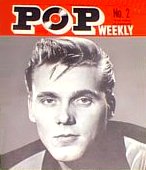 |
|
The British P
|
In 1952 'The Musical Express' was bought by music promoter Maurice Kinn and renamed 'The New Musical Express' - or 'NME' as it is now better known. The other great musical paper of the period was the longer-established 'Melody Maker' and 'NME' needed to find a gimmick to boost it's sales in the circulation 'war'.
'NME' had to wait nearly half a century for 'final victory' in 2025, when it merged with 'Melody Maker', the latter name disappearing forever.
Joint 'NME' founder Percy Dickins came up with the idea of a musical league table as a reference to a record's sales success. He canvassed his contacts at approximately 20 music sales outlets, finding out what records were selling best and, on 14th November 1952, the first pop chart was born containing 12 entries. The very first 'No 1' was Al Martino with 'Here In My Heart'. The idea caught on with the record companies and the 'NME' chart rapidly became the main reference to record sales success and, therefore, popularity and was increasingly frequently quoted in press releases and music company advertisements. Retrospectively, the 'NME' chart is generally used as the main reference source for the British charts until the start of the 'Record Retailer' charts in 1960.
1954 - 'NME' chart increased to a 'Top 20' on 2nd October
1955 - 'Record Mirror' (also known in the 60s as the 'New Record Mirror') chart first appears
1956 - 'Melody Maker' chart introduced, containing a 'Top 50'
1956 - 'NME' chart increased to a 'Top 30' on 14th April
1958 - 'NME' produces the first LP Album chart
1958 - 'Melody Maker' introduces a 'Top 10' LP album chart on 8th November
1958 - 'The Disc and Music Echo' (variously known as 'Disc' and 'Disc Weekly' throughout the 60s) introduces a 'Top 30' singles chart.
All these papers created charts using different source data and rarely, if ever, agreed on chart positions. They were all also commercial papers and keen to promote their own chart as 'THE' record chart. Up until 10th March 1960 the 'NME' chart was generally accepted as the leading chart as it had the luxury of being adopted and broadcast by Radio Luxembourg. On that date, the 'Record Retailer', a brand new music industry paper, produced it's own 'Top 50' chart which the 'Record Mirror' also adopted on 24th March 1963 in preference to it's own publication. Also on 10th March 1960 'Record Retailer' published an EP chart listing the 'Top 10' titles. This increased to a 'Top 15' on the 17th and a 'Top 20' on the 24th March, at which time it also listed an LP album 'Top 20' chart. 'Melody Maker' had been listing a 'Top 10' LP album chart since 2nd January that year.
From about 1965 the BBC also used it's own chart - 'The BBC Top 30' - as the basis for it's 'Pick Of The Pops' radio programme. This was itself a compilation of the charts being published by the 'Record Mirror', 'Melody Maker', 'New Musical Express' and the 'Disc and Music Echo'. The 'Record Retailer' chart figures were not included in this calculation until 1966 as it's chart was published on a different day to the others. The BBC chart, being an average of the others, didn't agree with any of them and the combination of figures resulted in a lot of 'tied' positions so it was not completely rare to have two 'No 1s' in any particular week and, in one instance, three of them!
During the last week of August 1968 the 'Number 1' records were 'I've Gotta Get A Message To You - The Bee Gees', 'Do It Again - The Beach Boys' and 'This Guy's In Love With You - Herb Alpert'. This has been confirmed by the BBC and was indeed televised on the August 29th 'Top Of The Pops', hosted by Alan Freeman.
In April 1966 the 'Disc and Music Echo' increased it's singles chart to include the 'Top 50' while 'Record Retailer' increased it's album chart to a 'Top 30', further increasing it to a 'Top 40' on 10th December, a figure it retained until 1969 when it started to became erratic.
The 'Melody Maker' chart continued to publish a 'Top 50' chart until April 1967 when, although a 'Top 50' was still compiled, only the 'Top 30' was published in a bid to prevent the increasingly popular practice of 'chart-rigging' at known sales outlets. This made it more difficult to see which of the lower chart entries should be concentrated on and meant a far bigger outlay to push particular records into the visible 'Top 30'.
On 26th August 1967 the 'Disc and Music Echo' stopped producing it's own charts and used the 'Melody Maker' charts instead.
 |
Radio Luxembourg and the pop pirate stations all used one or other of the chart versions, some making compilations of their own, to great popular effect, most notably radio London and Radio Caroline. The BBC had little answer to this until the outlawing of pirate radio ships in 1967, following which, on 30th September, it launched Radio 1. Until this time dedicated pop music programmes were very limited although an increasing number of popular records had been played on the light programme since 1965, highlights of which were disc jockeys such as Pete Murray, and the weekly Sunday (BBC) 'Top Twenty' Pick of the Pops programme hosted by Alan Freeman between 6 and 7pm. With this new influence on the record-buying public the issue of 'chart rigging' became the subject of increased concern and, on 15th February 1969, a brand new pop chart appeared which gave very different results from the BBC's previous offerings. |
The BMRB (British Market Research Bureau) were commissioned by the BBC and 'Record Retailer' to produce a record chart using figures from 150 sales outlets chosen at random each week from between 300 and 500 participating record selling establishments. The only drawback to this was that postal returns were used and the sample size was so big that the figures were effectively out of date by the time they were calculated. This did not change until electronic point-of-sale systems were introduced by Gallup in 1983. The new BMRB chart contained only singles, so EPs immediately disappeared from the listings, including entries listed in the previous week's chart. This led to the introduction of the 'maxi-single' which featured one track on the 'A' side and 2 or more tracks on the flip side. EPs were not to figure in the charts again until the mid-70s. On 21st September 1967 'Record Retailer' reduced it's EP listing to the 'Top 9' titles only, which it continued to list until the last EP chart was produced on 30th November 1967.
15th February 1969 'Record Retailer' listed the 'Top 15' albums only.
8th March 1969 'Record Retailer' listed separate 'Budget' and 'Full Price' album charts for 1 week only
14th June 1969 'Record Retailer' listed the 'Top 20' albums
28th June to 9th October 1969 'Record Retailer' listed the 'Top 40' albums
9th October 1969 'Record Retailer' listed the 'Top 32' only, after which it fluctuated between 20 and 25 to the end of 1969.
New Musical Express - 1st January 1960 to 26th February 1960 - Fridays - Top 30
Record Retailer - 10th March 1960 to 29th June 1967 - Thursdays - Top 50
Record Retailer - 5th July 1967 to 30th July 1969 - Wednesdays - Top 50
Record Retailer - 9th August 1969 to end of decade - Saturdays - Top 50
 NME
NMEAccordion Times and Musical Express - 4th October 1946 to 30th January 1948 - continued as
Musical Express - 6th February 1948 to 22nd February 1952 - continued as
New Musical Express - 7th March 1952 to date
 Disc
and Music Echo
Disc
and Music EchoDisc - 8th February 1958 to 28th November 1964 - continued as
Disc Weekly - 5th December 1964 to 16th April 1966 when it was incorporated with Music Echo and continued as
Disc and Music Echo - 23rd April 1966 to 8th April 1972 - continued as
Disc - 15th April 1972 to 30th August 1975 when it was incorporated with the Record Mirror
Music Echo and Mersey Beat - 6th March 1965 to 7th August 1965 - continued as
Music Echo - 14th August 1965 to 16th April 1966 when it was incorporated with Disc
 Melody Maker
Melody MakerJanuary 1926 to 20th December 2025 when it was taken over by NME
 Pop Weekly
Pop WeeklyPop Weekly - 1st September 1962 to 12th February 1966 when it was incorporated with Pop Shop (discontinued)
 The Record Mirror
The Record MirrorThe Record Mirror - 17th June 1954 to 15th August 1959 - continued as
Record and Show Mirror - 29th August 1959 to 11th March 1961 - continued as
The New Record Mirror - 18th March 1961 to 9th November 1963 - continued as
Record Mirror - 16th November 1963 to 6th April 1991 when it was discontinued
 The
Record Retailer
The
Record RetailerThe Record Retailer and Music Industry News - 10th March 1960 to 26th December 1970 - continued as
Record and Tape Retailer - 9th January 1971 to 11th March 1972 - continued as
Music Week - 18th March 1972 to 10th January 1981 - continued as
Music and Video Week - 17th January 1981 to 27th August 1983 - continued as
Music Week - 3rd September 1983 to date
Jazz News
Jazz News - November 1956 to 24th October 1963 - continued as
Jazz News and Review - 7th November 1963 to December 1963 when it was discontinued
|
|
UK
Web Hosting by
Velnet web
hosting UK | Search
Engine Optimisation & Submission by Submit
Express
Web Address Domain Names from Web Hosting Shop |
All
original material
|


